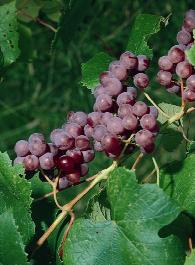Vitis labrusca x Vitis vinifera

Description:
The Catawba grapevine (perennial) produces a dull purple-red, seedless grape from September to October on a deciduous vine. It is a cross between the Concord grape (Vitis labrusca) and the common grapevine (Vitis vinifera) that grows well in places with cold winters and humid summers. It is grown predominantly on the East Coast of the United States and is used for commercial purposes such as jelly, jams, and wine.
Cultivation Tips:
- If you are in hardiness zones 5-8, you can grow your own Catawaba grapes in full sun for at least 6 hours a day.
- This vine prefers acidic, sandy soil that is well-drained.
- However, they can tolerate most soil besides really wet and alkaline soils.
- Self-pollinates
- Make sure you have the space because at their mature size they are about 5-7 feet tall when supported by a fence or trellis and can spread about 8-10 feet.
- Once established, water the vine occasionally and more in great heat.
- Prune during the winter so that the foliage is manageable and does not provide too much shade later on.
Uses:
Catawba grapes are the main grape used in American juice and wine and are very good in jams and jellies.
Companion Plants:
- Blackberry
- Rosemary
- Fig
- Lavender
- Rose
Sources:
https://www.monrovia.com/catawba-grape.html
https://www.arborday.org/trees/treeguide/TreeDetail.cfm?ItemID=842